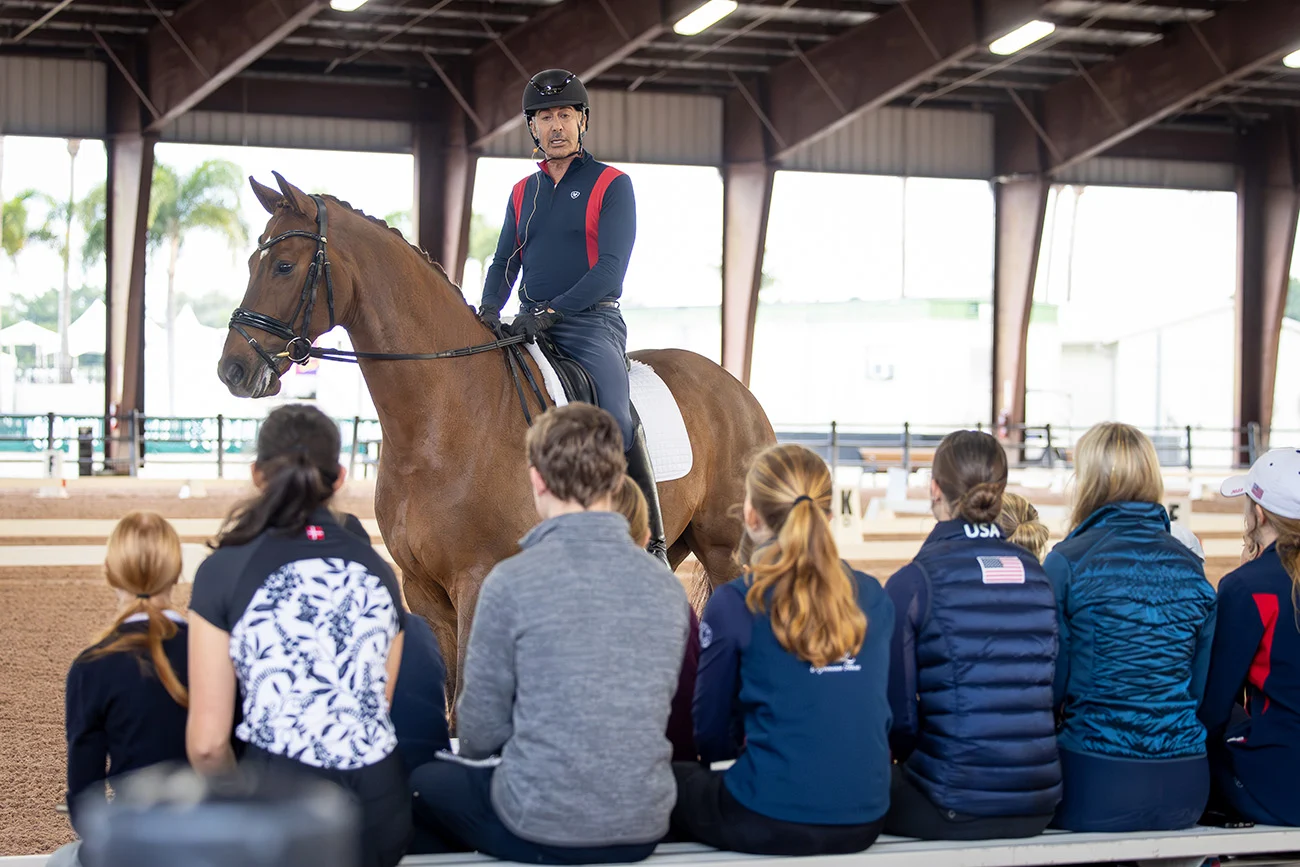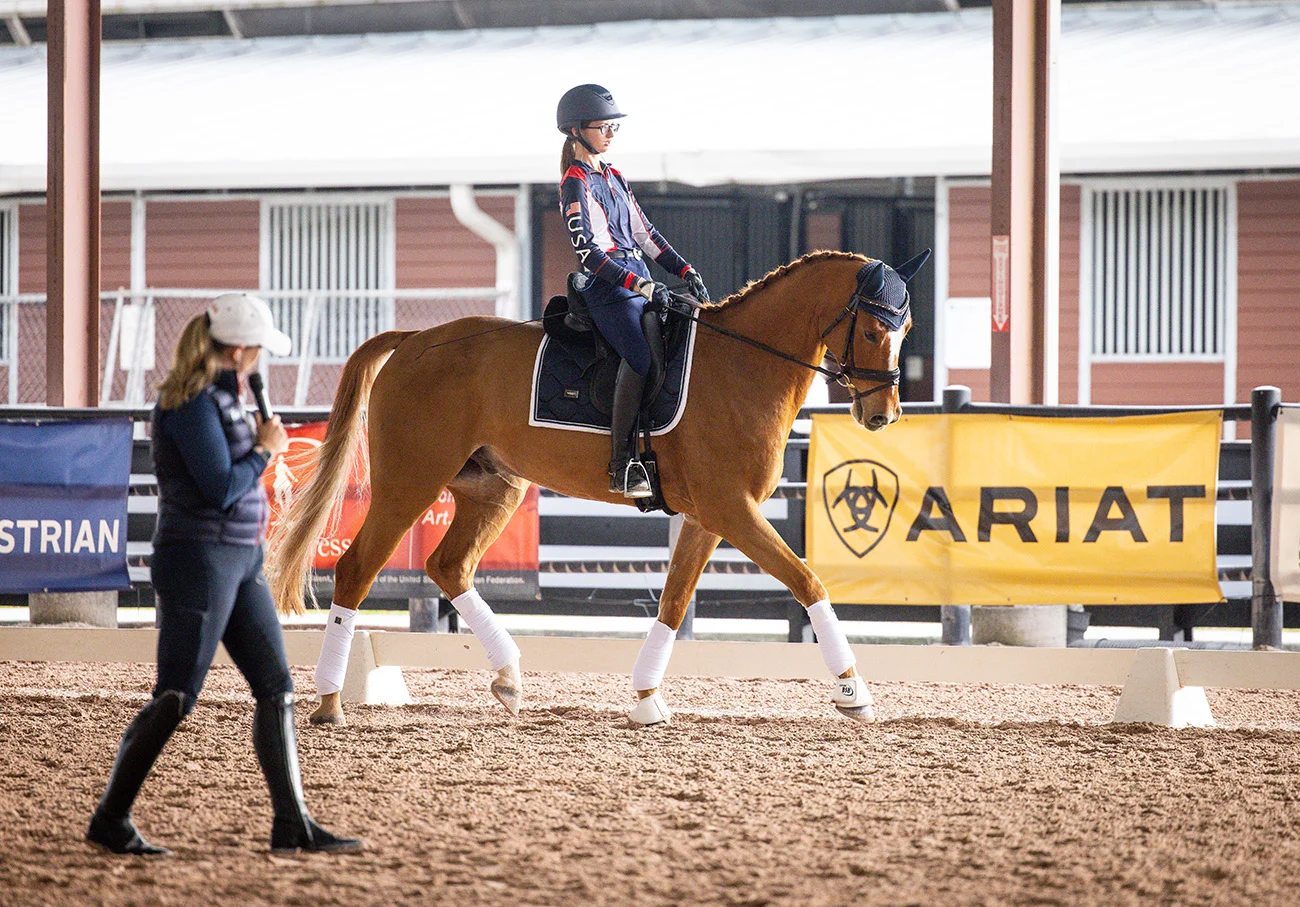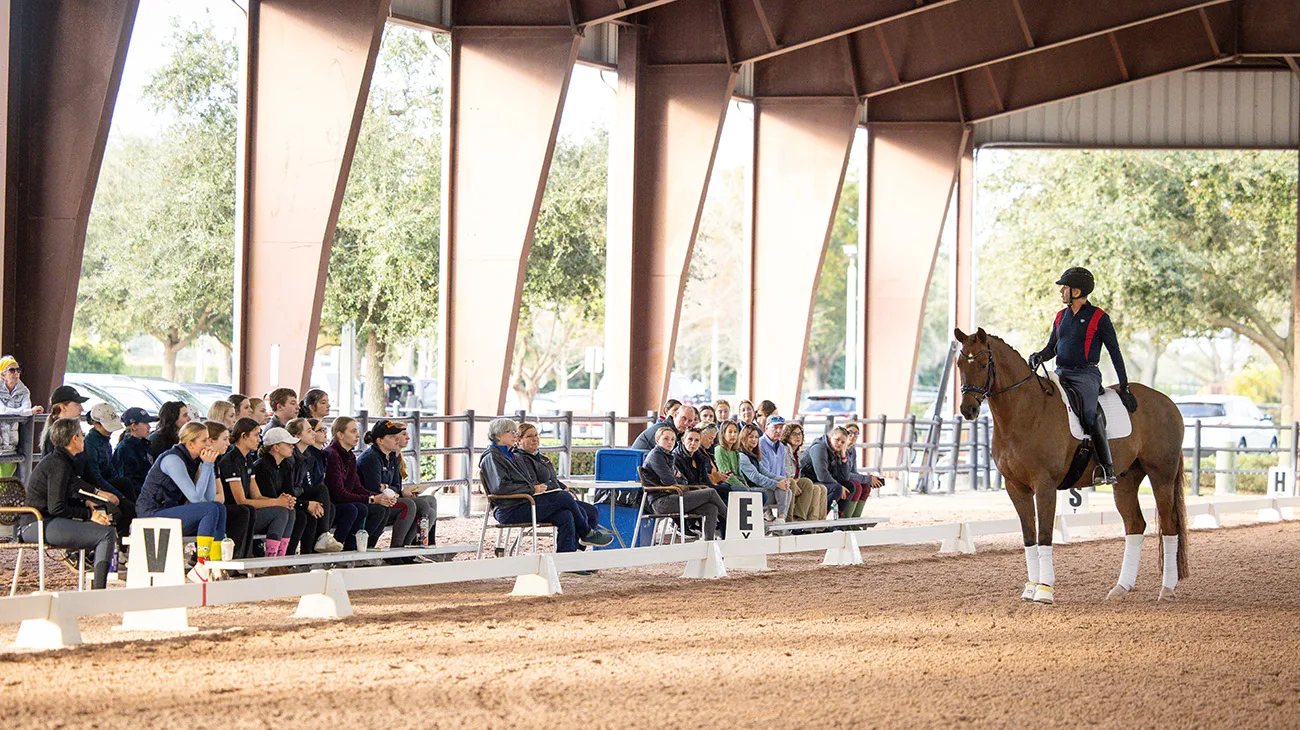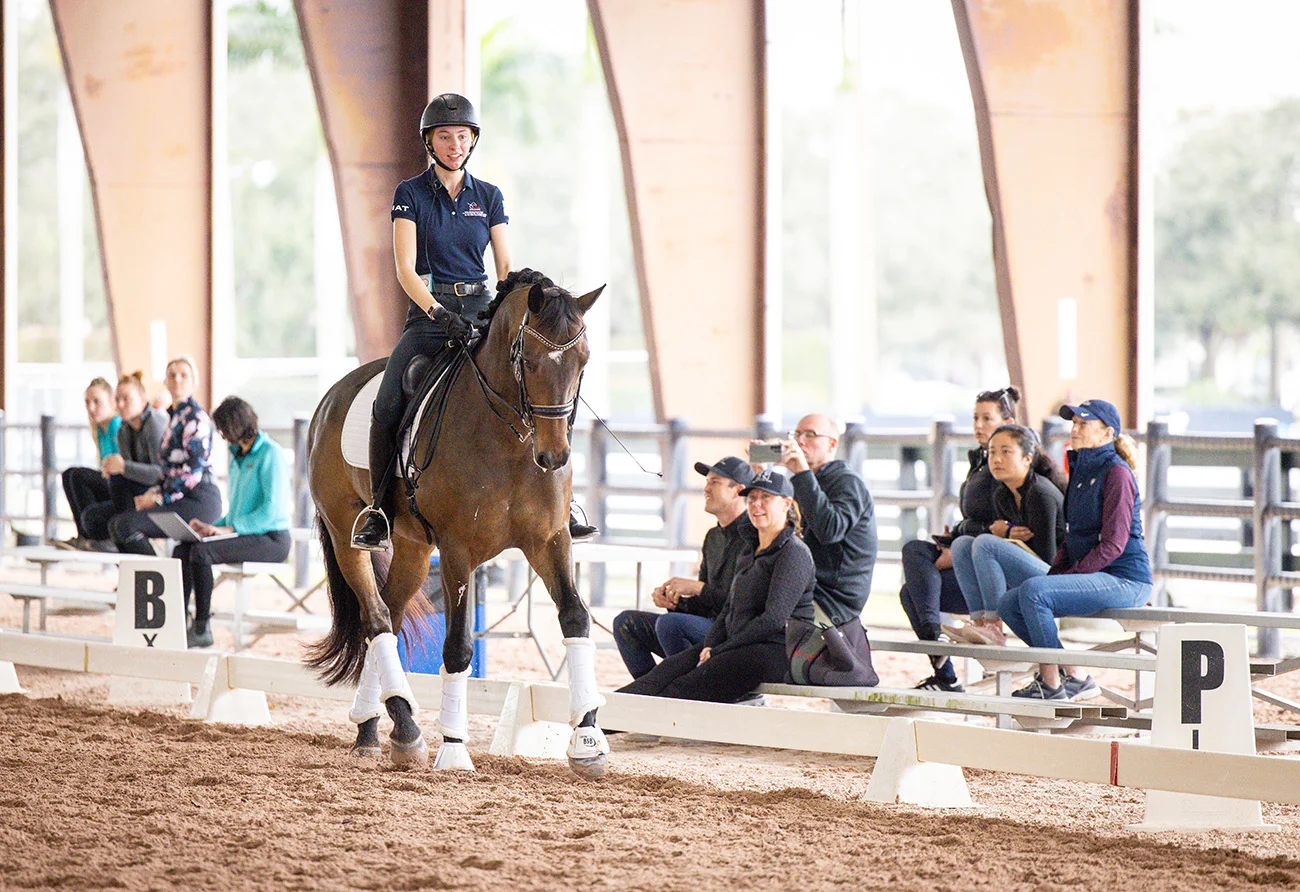Wellington, Fla.—Jan. 4
Twenty of the United States’ top young athletes have gathered at the Adequan Global Dressage Festival show grounds to participate in the 2024 Robert Dover Horsemastership Clinic Week, which started Thursday with a demonstration ride by host Dover and lessons for the participating riders.
Alongside access to a wide variety of lectures on topics from dressage theory to barn management, participants have four lessons with one of the clinicians over the course of the clinic, which ends Sunday. This year, the clinicians are Olivia LaGoy-Weltz, Ali Brock, Katie Duerrhammer and Sarah Tubman.
From young horse tests to Grand Prix movements, Thursday’s lessons addressed a wide variety of exercises. Influencing the horse with the quietest aids possible was a theme across many of those from the very beginning of the day, even before the first participants got into their saddles.

Robert Dover: Patience And Praise
Repeating what he did in last year’s clinic, Dover began the first day of lessons with a ridden demonstration, this year aboard his own Vitalissimo, a rising 7-year-old gelding he has owned since the chestnut was 3 months old.
The Dutch Warmblood has only been off his home property once before during the year he has been stateside, but if his lack of exposure made him nervous, it wasn’t apparent to auditors. The affable gelding happily moved through his paces for Dover, who could often be heard murmuring “good boy” under his breath.
Why was he so quick to praise his horse? “Because you can’t train a seal without fish,” Dover said. “A ‘good boy,’ a pat and a sugar—in his world, in his mind—mean everything.
“So often you see riders going around with stern faces, and it makes me sad because that horse is not being let in on the secret of how wonderful he or she is being,” the four-time Olympian continued. “The more they understand what they mean to us, and that we belong to them as their person, the more they’re going to want to work with you, like a dance partner, and go into battle in the arena for you as opposed to being coerced by you.”
“A ‘good boy,’ a pat and a sugar—in his world, in his mind—mean everything. So often you see riders going around with stern faces, and it makes me sad because that horse is not being let in on the secret of how wonderful he or she is being.”
Robert Dover
This kind of positivity is inherent in “classical” dressage, Dover said.
“I use that word cautiously because it has been used to be more destructive than productive—if competitive dressage is not classical generally, it may win some classes, but it’s not going to win over time,” he said, adding, “When I say ‘time,’ I mean years. That kind of riding is going to be talked about until it delegitimizes itself. Under huge amounts of pressure, horses can do very fancy things, but in the long run, if they don’t finish happy, that doesn’t work. They should go home as fresh as you brought them out.”
For Dover, dressage is not about perfection but about the training, which requires patience.
“Training is not minute-to-minute, or day-to-day, or month-to-month,” he said. “With good training, it is year-to-year.”
ADVERTISEMENT
Olivia LaGoy-Weltz: Avoid The ‘Galumph’
Leah Drew, Lincoln, Massachusetts, told her clinician LaGoy-Weltz that her horse sometimes loses his focus in their work. LaGoy-Weltz had Drew work on transitions within gaits, to hold the attention of the 13-year-old Westphalian gelding, Damon’s Davian, and to make sure that he stayed light on his feet. Bringing him forward and back on a variety of different lines—not just on the long side—prevented “Dezi” from getting slow, stiff and generally “galumphy” LaGoy-Weltz said.
“Sometimes he looks like he would like to go at one speed and at one speed only. He has this very nice canter technique in which he just wants to stay big and slow, but sometimes, you want them to get reactive, quicker, while staying elastic.”
LaGoy-Weltz pointed out that Dezi’s body language revealed the extent to which his attention was on Drew.
“Did you see his ears there?” LaGoy-Weltz asked Drew as the gelding’s expression changed in their canter work. “For a second, they relaxed to the side, but then a second later, he had laser ears. You want to read his ears a bit, asking him questions when you feel him lose focus.”
Katie Duerrhammer: Believe In Your Horse
Straightness was the name of the game for Lexie Kment, Palmyra, Nebraska, whose 7-year-old Hanoverian gelding Sir Limoncello tended to rely on his neck to maintain his balance.
“You need to be able to do all things—basically, bend, go straight, go forward—so you need to make sure that not just one of those things is the way that you find balance,” Duerrhammer told Kment. “Keep his nose in the center of his chest. You shouldn’t change the shape of his neck to fix the feeling you don’t like. In order for him to get suspension, he’s got to get the straightness on his hind legs.”

Changing “Lemon’s” balance also changed the way he felt in the bridle. Again, patience and quiet aids proved to be essential to the pairs’ success.
“It’s really important, especially with young horses: even if you don’t like the feeling, don’t instantly try to fix it,” Duerrhammer said, as she had Kment and Lemon ride three-loop trot serpentines. “You cannot tell him all the time where to put everything, all his long limbs.”
Having faith that the young horse would eventually find the right answer, Duerrhammer encouraged Kment to endure the moments that felt less-than-stellar.
“You want to challenge him in a way that says, ‘You can do this, I believe in you; you can be successful, and we’re going to figure out how to do this together,’ ” Duerrhammer said.
Eventually, improving his straightness empowered the gelding to swing more and settle into a consistent place in the connection.

Ali Brock: The Importance Of Position
ADVERTISEMENT
Campbell Jones, Saline, Michigan, worked on maintaining an effective position aboard her own 11-year-old Belgian Warmblood N’Oubliez Jamais in her lesson with Ali Brock. She and “Norman” have had their fair share of competitive success, including an average of over 70% at Prix St. Georges/Intermediaire I last competition year, but Brock set her sights even higher for the pair.
“You are clearly getting it done, but I need you to get it done in a way that’s easier. In dressage, what’s interesting about the horses is that they sometimes mimic what we do,” Brock said. “If we’re collapsed, they’re collapsed. Good riding is not about being tight or trying to hold ourselves, because we don’t want that in our horses.”
Brock got creative with the ways in which she encouraged Jones to sit deeper in her pelvis.
“Have you ever done a sit-a-buck class? Do they still have those, or does that question make me old?” Brock asked Jones, who answered in the negative. “Either way, think that if you put a dollar under your butt, you could keep it there.”
A few moments later, Brock checked in.

“How does that feel? Like work? Good. I like making people work,” she said.
Improving Jones’ position will enable her to ride small corrections so that she doesn’t have to ride big ones in the competition arena, Brock told the young rider.
“I’m gonna be on you, like white on rice, about your position,” she said. “Because he feels when you’re collapsed, and he would pull through you if he weren’t so polite in the hand.”
Sarah Tubman: Forget The Quick Fix
In Franki Kesner’s lesson, Tubman was quick to point out she is a good test rider—but added that skill is both a blessing and a curse. As she and her own 11-year-old Dutch Warmblood IL Divo worked on making their walk-trot transitions “upward” rather than forward, Tubman noticed the Hampton, New Jersey-based rider had a tendency to shake the gelding off her left rein as a quick fix to a throughness issue.
“Don’t do those quick fixes,” Tubman implored. “I can tell you’re good at those. And yeah, OK, you’re going to get through the test if you’re in one. But if you rely on quick fixes too much, then you can’t develop him.”
Tubman acknowledged that temporary corrections are useful and, therefore, tempting. Nevertheless, often they do more harm than good.
“The quick fixes only last so long, and they always come out somewhere else,” she said. “Rather than shaking him off the left rein, find a fix that might take half a circle but that will last longer, that isn’t faking it until you make it. Resist the urge to shake the bit quickly.”
The 2024 Robert Dover Horsemastership Clinic Week continues daily through Sunday. U.S. Equestrian Federation fans, subscribers and members can watch a live stream of the riding sessions on USEF Network powered by ClipMyHorse.TV














